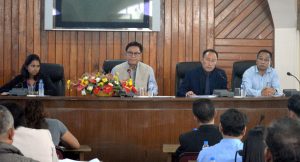Nagaland
Dept. pulls up underperforming schools; demands explanation

Our Correspondent
Kohima, June 20 (EMN): Nagaland’s department of School Education is said to consume the highest amount of money for salary but the result produced by schools in the department at the High School Leaving Certificate (HSLC) examinations year after year continue to be stagnant with the pass percentage below 50%.
This year, only 1738 students out of 4263 from 233 government schools qualified the HSLC exams, with 27 government high schools (GHS) yielding nil pass percentage. 61 GHS did not appear the said exam.
Against this backdrop, the department on Wednesday pulled up the authorities of the 27 schools to explain why their institutions produced nil result. This was done during a review meeting with the heads of government schools including principals, headmasters, assistant headmasters, teachers in charge, district education officers (DEO) and SDEOs of various districts, officers of the directorate and the Nagaland Board of School Education (NBSE) to introspect the performance of government schools.
Most of the 27 non-performing schools are in the rural areas and the reasons for the nil result cited by the school authorities were similar: poor educational foundation at primary and elementary levels, shortage in teaching staff particularly of math and science subjects, absence of administrative head of institution or headmaster and assistant headmasters, illiteracy of parents leading to lack of support and encouragement to their wards, less effort by students towards studies and giving more priority to help parents in farming. Some of the representatives also pointed out that teachers employed under RMSA and SSA participating in frequent agitations due to salary issues, have hampered the normal functioning of classes in 2017.
A teacher from GHS Anatongre under Kiphire district shared his concern that due to lack of basic knowledge foundation, there was a linguistic gap. This, he said, was coupled by the economic problem of the parents that they were unable to afford purchasing textbooks for their children and the latter depend mainly on teachers’ notes. Another school representative said extra coaching classes were initiated but were not taken positively by parents and guardians as they wanted their wards to return home early to help with chores.
For GHS Chingmei under Tuensang, there were no mathematics and science teachers posted in the school since 1998. The school representative stated that there were instances where even a Hindi teacher had to take responsibility of teaching mathematics and science to students.
Most of the school authorities also agreed that the non-detention policy of the government was also a setback as students who needed more attention in lower classes get promoted to higher classes, while many students and teachers also take advantage of the policy by staying away from the classes. One of the representatives also pointed out that many teachers take leave to undergo required trainings, however, this was cut short by the principal secretary School Education Menukhol John who stated when in-service training is allowed, there were provisions to pay the salary of a substitute teacher. Therefore, he asserted such excuses should be avoided.
The official asked all the DEOs to flag the issues and challenges raised by the schools and take steps to address them on priority.
“We are talking about the future of our children. We owe it to our state and our children,” John told the gathering. He also questioned the excuse of shortage of teachers when most of the nil performing schools had sufficient teachers. Only six among the 27 GHS has less than 10 teaching staff.
Principal Director of School Education Smita Sarangi, who delivered the keynote address, highlighted that 66.95 percent of the total government schools’ pass percentages were below 40 percent. She stated that out of the 27 GHS which produced nil result, 23 has enrolment of less than 10 and students of five GHS have not appeared the HSLC exam.
Authorities of 10 of said 27 GHS failed to turn up at the meeting, for which the Advisor for School Education KT Sukhalu and the principal secretary Menukhol John have conveyed word to meet them within a week’s time with proper clarification regarding the poor performance of their institutions as well as their absence at the meeting. These schools include GHS of Diki, Sangsanyu, Longching, Totokchingnyu, Mopong, Kilomi, Seyochung, Phisami, Pongo and Yongnyah.
Other issues that were discussed during the review meeting included communitization act and minimising the powers of the village education council/school management council, proxy teachers issue, award for the best performing government school so as to motivate students and teachers etc. With regard to the issue of proxy teachers, the director of School Education Wothungo Tsopoe said that the department was unable to do anything as it was yet to receive any actual report or complaint.
Looking back on the performance of the government schools in the last five years, 24 GHS had nil results in 2014 while the number increased to 38 in 2015, and then came down to 30 in 2016 and 2017. In contrast, private schools soar with more than 80 percent of total students which is often threefold or more of those from government institutions, clearing the exams each year.

